A financial service called microcredit, commonly referred to as microfinance, offers modest loans to low-income people or groups who have little access to conventional banking services. It seeks to reduce poverty, encourage entrepreneurship, and give people the tools they need to launch or grow their own small enterprises. In this post, we’ll examine what microcredit is, how it operates, the various kinds of loans it may be used for, its advantages, and some noteworthy microcredit programmes. Understanding microcredit will help you appreciate how important it is for fostering financial inclusion and economic expansion.
Meaning of Micro Credit
Microcredit refers to the provision of small loans, typically without collateral, to individuals or groups who lack access to formal banking systems. These loans are often granted to entrepreneurs, small business owners, and self-help groups in rural and underserved areas. Microcredit aims to support income-generating activities, improve livelihoods, and uplift individuals from poverty by providing them with financial resources to start or expand their businesses.
How Does Microcredit Work?
Microcredit operates through Microfinance Institutions (MFIs) or Non-Governmental Organizations (NGOs) that specialize in providing financial services to the underprivileged. The process involves the following steps
Borrower Assessment: MFIs evaluate the creditworthiness of potential borrowers by assessing their repayment capacity, business viability, and social background.
Loan Disbursement: Upon approval, borrowers receive the loan amount, which is often accompanied by financial literacy training and mentorship to ensure responsible use of funds.
Repayment: Borrowers are expected to repay the loan in regular installments, often with affordable interest rates, over a predetermined period.
Credit History Building: Successful repayment builds the borrower’s credit history, enabling them to access larger loans in the future.
Different Types of Micro Credits
Microcredit encompasses various forms, including
Individual Microcredit: Loans provided to individuals for business or personal purposes.
Group-based Microcredit: Loans granted to self-help groups or solidarity groups, where members collectively guarantee each other’s loans.
Agricultural Microcredit: Loans tailored specifically for agricultural activities, such as farming, livestock, or fisheries.
Microenterprise Development: Loans focused on supporting the growth and development of microenterprises.
Consumer Microcredit: Small loans provided for household consumption or personal emergencies.
What are the Benefits of Micro Credits?
Microcredit offers several advantages, including
Financial Inclusion: It provides access to financial services for individuals who are excluded from traditional banking systems.
Microcredit empowers individuals to generate income, create employment opportunities, and improve their standard of living.
Women Empowerment: Microcredit often targets women, enabling them to become financially independent and contribute to household income.
Entrepreneurship Promotion: It encourages entrepreneurial activities, fosters innovation, and drives economic growth at the grassroots level.
Community Development: Microcredit strengthens local economies, promotes social cohesion, and contributes to sustainable development.
List of Schemes of Micro Credits
There are several notable microcredit schemes globally, such as
Small Industries Development Bank of India (SIDBI)
Pradhan Mantri Mudra Yojana (PMMY)
Stand-Up India Scheme
National Handicapped Finance and Development Corporation (NHFDC)
National Urban Livelihoods Mission (NULM)
Mahila Samridhi Yojana
Micro Units Development and Refinance Agency Ltd. (MUDRA)
National Bank for Agriculture and Rural Development (NABARD)
National Scheduled Tribes Finance and Development Corporation (NSTFDC)
These are some of the notable schemes in India that provide micro-credit or financial assistance to individuals, particularly those belonging to marginalized sections, to start or expand their micro-enterprises. These schemes aim to promote entrepreneurship, self-employment, and financial inclusion among the economically weaker sections of society. Each scheme has its own eligibility criteria, loan amounts, interest rates, and repayment terms. It is important for individuals to research and understand the specific requirements of each scheme before applying.
Also Read – 7 Home-Based Businesses You Can Start with a Business Loan
Conclusion
Microcredit plays a significant role in promoting financial inclusion and empowering underserved communities. By providing access to financial resources, microcredit helps individuals build credit history, develop entrepreneurial skills, and contribute to economic growth. Understanding the different types of microcredit and the benefits they offer can inspire individuals to explore microcredit opportunities and improve their credit control eligibility.
Frequently Asked Questions
What is an example of a microcredit?
A famous example of microcredit is the Grameen Bank in Bangladesh, which pioneered the concept of microfinance. It provides small loans to low-income individuals, particularly women, to start or expand their businesses.
What is the limit of a micro loan?
Microfinance loans encompass all loans provided to individuals from low-income households, specifically those with an annual income of up to Rs.3 Lakh, without the requirement of collateral.

